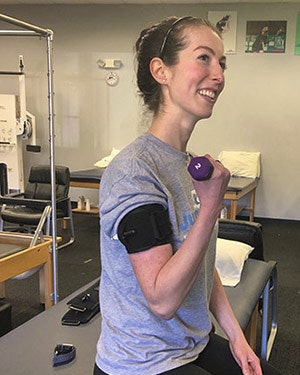


What is it? BFRT is a brief or partial blockage of blood flow with the use of inflatable cuffs. The cuffs are applied to either your upper arm or upper leg. When the cuffs are inflated, they limit the amount of blood flow from the veins going back to the heart and blood flow out to the limbs from arteries. The science of limiting the amount of blood flow has been shown to imitate what is typically seen during high-intensity exercise. By exercising in this "anaerobic state", the brain believes that the body is exercising at a much higher level. The result is the same type of gains that one would see with high-intensity training while using much less weight or resistance. It is, therefore, an efficient tool that improves strength, function, and muscle size in a much shorter amount of time.
Safety: It has been found to be safe when applied by a trained clinician. At JumpStart Physical Therapy we use the "Smart Tools Cuff system". With this system, the clinician measures pulse pressures by using a doppler and then calculates the appropriate pressure to ensure an accurate amount of blood flow restriction. Research shows that performing low-intensity exercise using BFRT does not increase coagulation of blood or inflammation and may actually help with the breakdown of clots. It has been proven to be safe, effective, and portable for people of all abilities. At this time the age ranges researched are from 15 years old up to patients over 70 years old.
How it is used: At, JumpStart, a certified Smart Tools physical therapist will calibrate the cuff for each individual patient. Exercises are patient dependent, but they will typically perform 3-5 different exercises during that session while wearing the inflatable cuffs. The cuffs can be worn for up to a total 20 minutes of continuous inflation.
Benefits: Improved gains in strength, recovery, pain mitigation, functional aerobic capacity, and increased muscle hypertrophy. Shorter time periods and less stress on the body than typical training.
Who can benefit: Pre-op, post-op, patients on bed rest, patients immobilized in cast or brace, and athletes.
